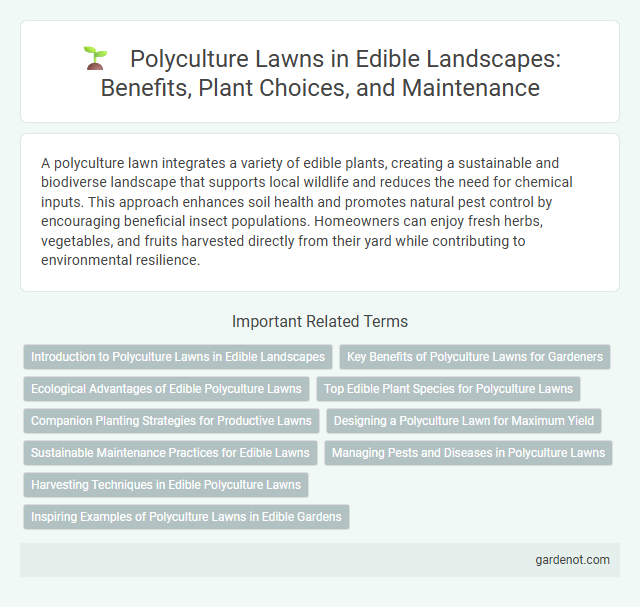A polyculture lawn integrates a variety of edible plants, creating a sustainable and biodiverse landscape that supports local wildlife and reduces the need for chemical inputs. This approach enhances soil health and promotes natural pest control by encouraging beneficial insect populations. Homeowners can enjoy fresh herbs, vegetables, and fruits harvested directly from their yard while contributing to environmental resilience.
Introduction to Polyculture Lawns in Edible Landscapes
Polyculture lawns in edible landscapes integrate diverse plant species, including grasses, legumes, and edible herbs, to create sustainable, low-maintenance green spaces that produce food while supporting biodiversity. These lawns improve soil health through nitrogen fixation and natural pest resistance, reducing the need for synthetic fertilizers and pesticides. By combining various plants with complementary growth habits, polyculture lawns enhance ecosystem resilience and provide continuous harvests throughout the growing season.
Key Benefits of Polyculture Lawns for Gardeners
Polyculture lawns enhance biodiversity by integrating multiple plant species, which improves soil health and reduces pest outbreaks naturally. This diverse plant ecosystem supports beneficial insects and promotes efficient water usage, lowering maintenance costs for gardeners. Growing a polyculture lawn also increases resilience against extreme weather conditions, ensuring a sustainable and productive garden environment.
Ecological Advantages of Edible Polyculture Lawns
Edible polyculture lawns promote biodiversity by integrating multiple plant species that support pollinators and beneficial insects, enhancing ecosystem resilience. These lawns improve soil health through diverse root systems that increase nutrient cycling and reduce erosion. Water efficiency is heightened as mixed plantings optimize moisture retention and decrease irrigation needs compared to traditional monoculture lawns.
Top Edible Plant Species for Polyculture Lawns
Polyculture lawns integrate diverse edible plant species such as clover, creeping thyme, and white dutch clover, which enhance soil fertility and provide ground cover. These plants support pollinators, reduce the need for synthetic fertilizers, and offer nutritious forage options. Including resilient species like chamomile and wild strawberries promotes biodiversity and creates a sustainable, low-maintenance edible landscape.
Companion Planting Strategies for Productive Lawns
Polyculture lawns integrate diverse edible plants using companion planting strategies to enhance soil health, reduce pests, and increase overall productivity. Species such as clover, chamomile, and wild strawberries work synergistically to fix nitrogen, attract beneficial insects, and provide ground cover, promoting a resilient and sustainable lawn ecosystem. This approach minimizes the need for synthetic fertilizers and pesticides while yielding edible harvests and maintaining aesthetic lawn qualities.
Designing a Polyculture Lawn for Maximum Yield
Designing a polyculture lawn for maximum yield involves strategically combining multiple edible plant species to optimize space, soil health, and biodiversity. Incorporating nitrogen-fixing legumes alongside deep-rooted perennials enhances nutrient cycling and reduces fertilizer needs, while selecting groundcovers, herbs, and small fruiting plants creates layered food production. This approach maximizes edible output, supports pollinators, and improves resilience against pests and environmental stress.
Sustainable Maintenance Practices for Edible Lawns
Polyculture lawns integrate diverse edible plants, reducing reliance on synthetic fertilizers and pesticides by enhancing soil health naturally. Sustainable maintenance practices include the use of organic mulches, companion planting, and manual weed control to support biodiversity and soil moisture retention. Regular monitoring of plant diversity and soil nutrient levels ensures a resilient, productive edible lawn that minimizes environmental impact.
Managing Pests and Diseases in Polyculture Lawns
Polyculture lawns inherently enhance pest and disease management by fostering biodiversity, which naturally disrupts pest life cycles and reduces the risk of widespread infestations. Diverse plant species create habitats for beneficial insects and predators that control harmful pests, minimizing the need for chemical interventions. Regular monitoring and selecting disease-resistant plants further promote a resilient, healthy polyculture lawn ecosystem.
Harvesting Techniques in Edible Polyculture Lawns
Harvesting techniques in edible polyculture lawns involve targeted removal of mature crops to maintain biodiversity and promote continuous growth. Selective harvesting ensures that multiple plant species coexist without depletion, enhancing soil health and resilience. Proper timing and gentle handpicking prevent damage to surrounding plants, supporting sustainable yields in polyculture systems.
Inspiring Examples of Polyculture Lawns in Edible Gardens
Polyculture lawns in edible gardens showcase diverse plant species like clover, wildflowers, and low-growing herbs that improve soil health and attract beneficial insects. Examples include lawns with a mix of creeping thyme and chamomile that offer edible ground cover while reducing the need for mowing. These multifunctional lawns create sustainable, productive landscapes by combining beauty and nourishment.
Polyculture lawn Infographic

 gardenot.com
gardenot.com